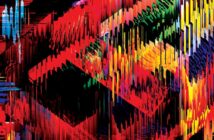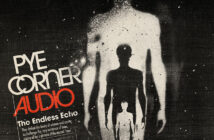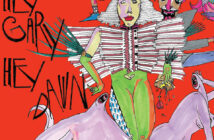Recorded at an unspecified event in 2012, Disturbed Communication is a single, set-length track from a quartet of noise artists. Elektrojudas, Sustained Development, Kim Jong-un and Exedo have come together as Knark Esion to explore noise as live performance over the album’s 25-odd minutes.
If there was a prevailing feeling behind the piece, it would be of deep space, of wavy, watery sounds battling against a howling solar wind. Evolving, bell-like tones crop up and there’s a gamut of pick slides along guitar strings that tip the lid to ‘Interstellar Overdrive’-era Pink Floyd.
For the most part, the recording is pushed into the red. There’s an almost indispensable wall of fog, of distortion which obscures the origins of the group’s noises, so the listener spends much time mystified. There’s some deeply creepy tones occasionally let down by stock patterns or playing which break the mood.
When it works, it’s great – what sounds like hell’s vibraslap plays in time with a martial beat. Ominous, immense organ heralds the coming of a pissed demon. Sawtooths and bandsaws bid for your attention. A sound like the scraping of rocks (used to such great effect in Einsturzende Neubauten’s ‘Wüste’) is in plentiful supply. But the overriding tone is of a mangled, almost-harsh wall of noise. Oddly, it’s when these tones drop out that the quartet’s work is best – it subtracts the brow-beating and replaces it with the paradoxical claustrophobia of deep space.
As is sometimes the case with collaboration, some opportunities are missed with this recording. It’s a noise release, so it’s a little much to expect a quieter set, but moments where a little more exploration of the quieter tones unfolding in the music – when certain ideas have been exhausted and the next has yet to kick in – would have paid dividends. There’s a feeling in some circumstances of playing for the sake of playing, when the key to improvisation is playing the most fitting part, rather than the busiest.
Improv obviously shouldn’t be wholly nailed down, but a rough outline is often a good idea, and it’s the lack of this which hamstrings this release – rather than feeling some sort of immense push towards an end – a whirling void still counts! – there’s more often the feeling of what-do-we-do-now? confusion which slackens the pace, often developed pretty thoroughly until such stumbles.
A quote from George Steiner’s In Bluebeard’s Castle (read the complete culture-busting essay here) adorns the back of the release.
The counterculture is perfectly aware of where to begin the job of demolition. The violent illiteracies of the graffiti, the clenched silence of the adolescent, the nonsense-cries from the stage-happening are resolutely strategic. The insurgent and the freak-out have broken off discourse with a cultural system which they despise as a cruel, antiquated fraud. They will not bandy words with it.
Fine sentiments, sure, but also a little nearsighted: it infers the release is sticking it to the man, but the music within isn’t anything too out of the ordinary for those who listen to noise or improv music. I understand the desire to nail one’s colours to the mast. However, if you’re going to pull out Steiner as your house sigil you should probably back it up by actually fucking shit up.
None of this is to say that the piece isn’t enjoyable – it is intriguing, and leaves the listener wishing some elements of the work were explored. It’s just that such a ballsy quote suggests a truly revolutionary content, and there’s nothing that hasn’t been done by other artists. Disturbed Communication has attitude behind it, but it doesn’t kick the listener in the ‘nads, at least not in the recorded artifact. Live may have been a different experience – but on record it sounds like a first sketch, albeit one with evocative moments.
LUKE MARTIN




